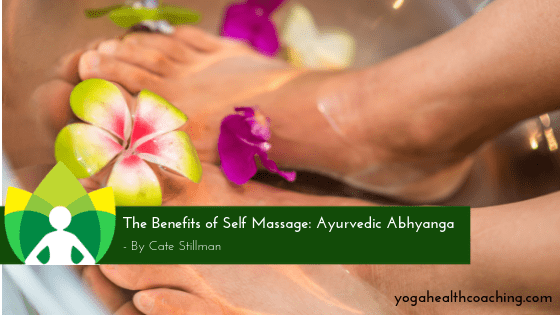
The Benefits of Self Massage: Ayurvedic Abhyanga
Print this handout and post on your fridge until it becomes second nature.
Time and again I hear from the Living Ayurveda Course students that self-massage has changed their lives.
The practice of self-massage is simple. In fact, here is a handout to print and post on your fridge until it becomes second nature. In Indian culture, where Ayurveda originates, it’s a daily practice that you would have first experienced in utero. Then, when you were born, you would have received “infant massage”. Infant massage leads to toddler massage. Toddler massage leads to small child massage. Etc. Etc. Etc. Soon you have cultivated an adult that knows how to take care of themselves by simply taking their health into their own hands.
What are the benefits of self-massage (abhyanga)?
What I recommend is to give yourself a massage (instructions here or below) and then assess how you feel. Sure, you can read this commonly printed list of benefits. While some benefits come from claims from the ancient Ayurvedic texts, studies are actually being done to qualify or dismiss these claims. Here is a list of claims commonly found on websites, substantiated byMAPI.
- Increased circulation, especially to nerve endings
- Toning of the muscles and the whole physiology
- Calming for the nerves
- Lubrication of the joints
- Increased mental alertness
- Improved elimination of impurities from the body
- Softer, smoother skin
- Increased levels of stamina through the day
- Better, deeper sleep at night
- To boost my immune system
- To make me feel whole again
- To nourish my body and soul simultaneously
Benefits of Child Massage
I also know that giving my daughter her massage creates these benefits:
- Creates a grounding, relaxing mood.
- Keeps her skin from drying out. (Dry skin indicates Vata is in the lymph system, which creates an easy target for bacteria or viruses to take root).
- Teaches her how to take care of her sacred body.
How to give yourself a massage:
Set aside some quiet time for your massage. 5-15 minutes is enough time to massage the oil on your body (preferably before you shower)– though if you have no time, rub the oil on your skin (instead of soap) in the shower. Do this daily.
You will need:
- Warm room: make this a comfortable and special time for yourself.
- Oil: sesame oil Vatas, sunflower or coconut oil for Pittas and olive or mustard oils for Kaphas.
- Squeeze bottle: for easy access throughout the massage fill a squeeze bottle with oil
- Hot water in a bowl or in the sink: put the squeeze bottle in the warm water and allow the oil to warm to at least body temperature
- Towel or mat: choose something that you don’t mind getting oily. You might want one to stand on and one to dry off with.
How to give yourself a Self-Massage (technique)
- Undress completely and stand on your towel or mat.
- Starting with a small amount of oil in your hands begin to gently rub the oil into your scalp. Massage the oil into your scalp and hair with your fingertips. If you would prefer to keep the oil out of your hair simply omit the use of oil for this part of the message.
- Vigorously work down your body until the oil has been massaged into every part of your body. Use long strokes on your limbs and circular strokes over all your joints, chest and abdomen. Cover every inch of skin, attuning to your bodily tissues with your hands. Spend extra time on areas that are less integrated (for some this is thighs, buttocks, breasts).
- Take ample time to massage the soles of your feet as this can have a particularly relaxing and soothing affect.
Rinse off the oil in the shower. Take time in the shower to allow the oil on your hands to mix with the water from the shower to massage your face and ears. Use gentle circular strokes to massage your cheeks and forehead, move out towards the ears in stroking motions around the eyes and lips. Soap is drying to the skin, including to the anus; try switching to oil instead.
Print this handout and post on your fridge until it becomes second nature.


